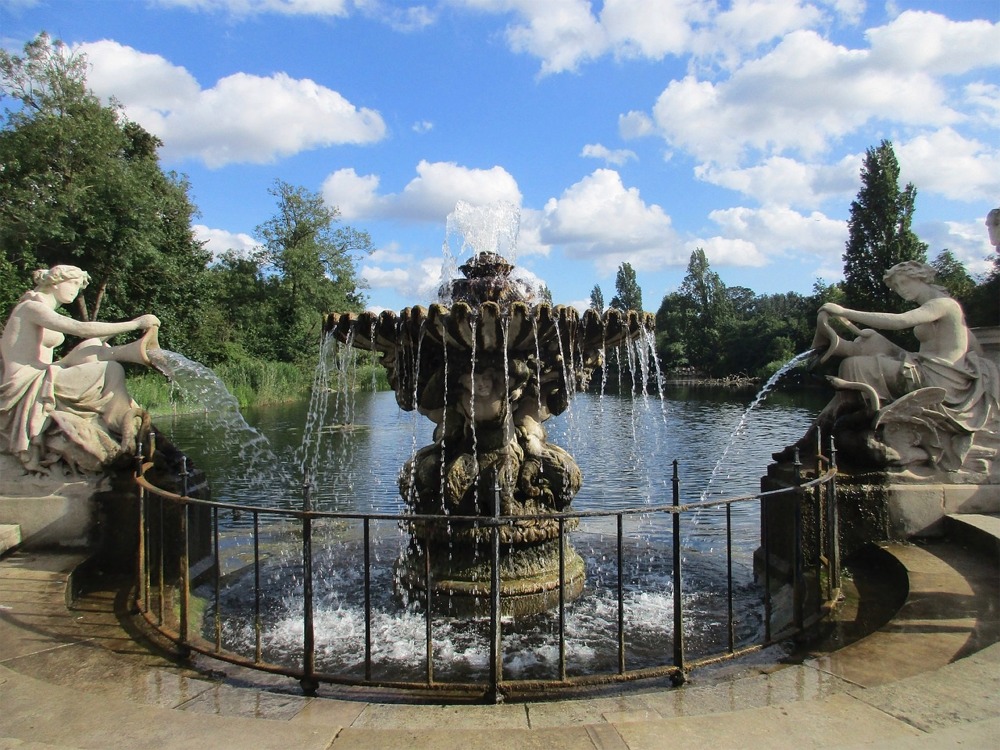Tazza Fountain
Italian Gardens Kensington
Home > Photos from England > London Gallery 3 > Tazza Fountain, Italian Gardens, Kensington

The Tazza Fountain is a magnificent sight. It stands on the southern end of the Italian Garden within the Kensington Gardens. The fountain was made of gleaming white marble, crowned with a great basin (tassa or wide shallow cup or bowl). The sound of the water is soothing, like a gentle song sung by a choir of angels. The shimmering droplets that catch the sunlight seem to be lit from within, like tiny stars twinkling in a night sky.
The fountain is a popular spot amongst visitors of the Garden, who often linger around it to drink in its beauty. Sometimes, in the distance, children can be heard playing, their laughter ringing out among the trees. It is a peaceful spot, a place of solace and respite from the chaos of the world outside. The Tazza Fountain will stand for many more years to come, a shining beacon of beauty amidst the garden's splendour.
Kensington Gardens
Kensington Gardens, once the private gardens of Kensington Palace, are among the Royal Parks of London. The gardens are shared by the City of Westminster and the Royal Borough of Kensington and Chelsea and sit immediately to the west of Hyde Park, in western central London. The gardens cover an area of 107 hectares (265 acres). The open spaces of Kensington Gardens, Hyde Park, Green Park, and St. James's Park together form an almost continuous "green lung" in the heart of London. Kensington Gardens are Grade I listed on the Register of Historic Parks and Gardens.
Background and location
Kensington Gardens are generally regarded as being the western extent of the neighbouring Hyde Park from which they were originally taken, with West Carriage Drive (The Ring) and the Serpentine Bridge forming the boundary between them. The Gardens are fenced and more formal than Hyde Park. Kensington Gardens are open only during the hours of daylight, whereas Hyde Park is open from 5 am until midnight all year round.
Kensington Gardens has been long regarded as "smart" because of its more private character around Kensington Palace. However, in the late 19th century, Hyde Park was considered more "fashionable", because of its location nearer to Park Lane and Knightsbridge.
History
Kensington Gardens was originally the western section of Hyde Park, which had been created by Henry VIII in 1536 to use as a hunting ground. Beginning under Queen Anne, it was designed by Henry Wise and Charles Bridgeman in order to form a landscape garden, with fashionable features including the Round Pond, formal avenues and a sunken Dutch garden. It was separated from the remainder of Hyde Park in 1728 at the request of Queen Caroline.
Bridgeman created the Serpentine between 1726 and 1731 by damming the eastern outflow of the River Westbourne from Hyde Park. The part of the Serpentine that lies within Kensington Gardens is known as "The Long Water". At its north-western end (originally the inflow of the River Westbourne), in an area known as "The Italian Garden", there are four fountains and a number of classical sculptures. At the foot of the Italian Gardens is a parish boundary marker, delineating the boundary between Paddington and St George Hanover Square parishes, on the exact centre of the Westbourne River. Kensington Gardens were opened to the public in 1841.
Buildings and monuments
The land surrounding Kensington Gardens was predominantly rural and remained largely undeveloped until the Great Exhibition in 1851. Many of the original features survive along with the Palace, and there are other public buildings such as the Albert Memorial (at the south-east corner of Kensington Gardens, opposite the Royal Albert Hall), Queen Caroline's Temple, the Serpentine Gallery, and Speke's monument. Queen Victoria commissioned the Italian Gardens and the Albert Memorial during a series of improvements.
Another feature is the bronze statue of Peter Pan by George Frampton standing on a pedestal covered with climbing squirrels, rabbits and mice. It is also home to the Diana, Princess of Wales Memorial Playground and a seven-mile Memorial Walk. A statue of Queen Victoria sculpted by her daughter, Princess Louise, to celebrate 50 years of her mother's rule stands outside Kensington Palace. The park also contains the Elfin Oak, an elaborately carved 900-year-old tree stump.
From Wikipedia, the free encyclopedia.


